Essay: Applying Motivation Theories in the Modern Workplace
VerifiedAdded on 2023/06/09
|8
|2109
|118
Essay
AI Summary
This essay provides a comprehensive overview of various motivation theories and their practical application within the modern workplace, with a specific focus on the retail giant Sainsbury. The introduction establishes the significance of motivation in enhancing employee performance and organizational success. The core of the essay delves into several key theories, including Maslow's Hierarchy of Needs, Herzberg's Two-Factor Theory, McClelland's Achievement Model, and Alderfer's ERG Theory, analyzing each theory's components and how they can be implemented to improve employee engagement and productivity. Each theory is examined in the context of Sainsbury, illustrating how the company can utilize these motivational tools to foster a positive work environment and achieve its business goals. The essay concludes by summarizing the importance of motivation and its impact on employee satisfaction and overall organizational success. The essay is well-researched and references relevant academic sources to support its arguments.
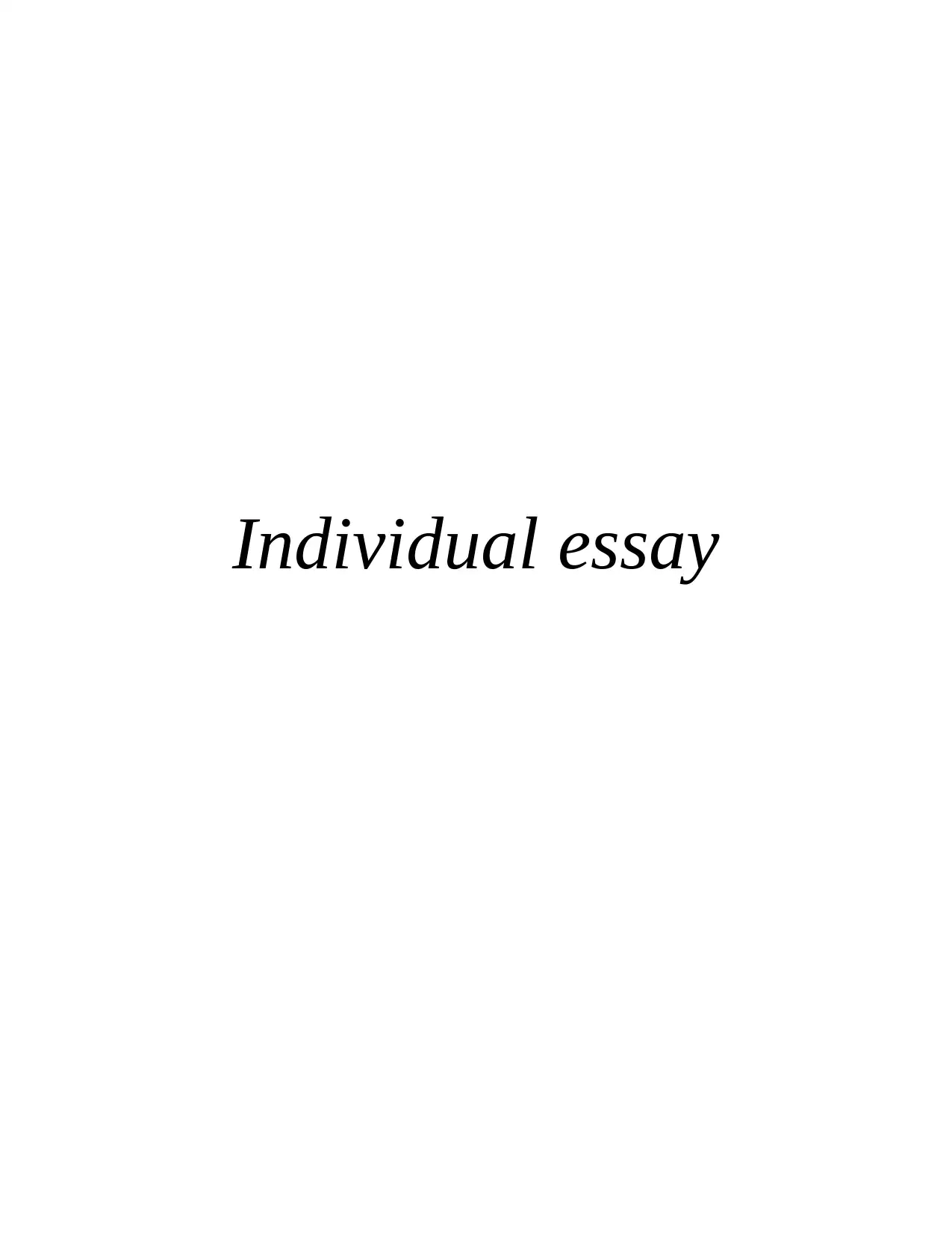
Individual essay
Paraphrase This Document
Need a fresh take? Get an instant paraphrase of this document with our AI Paraphraser
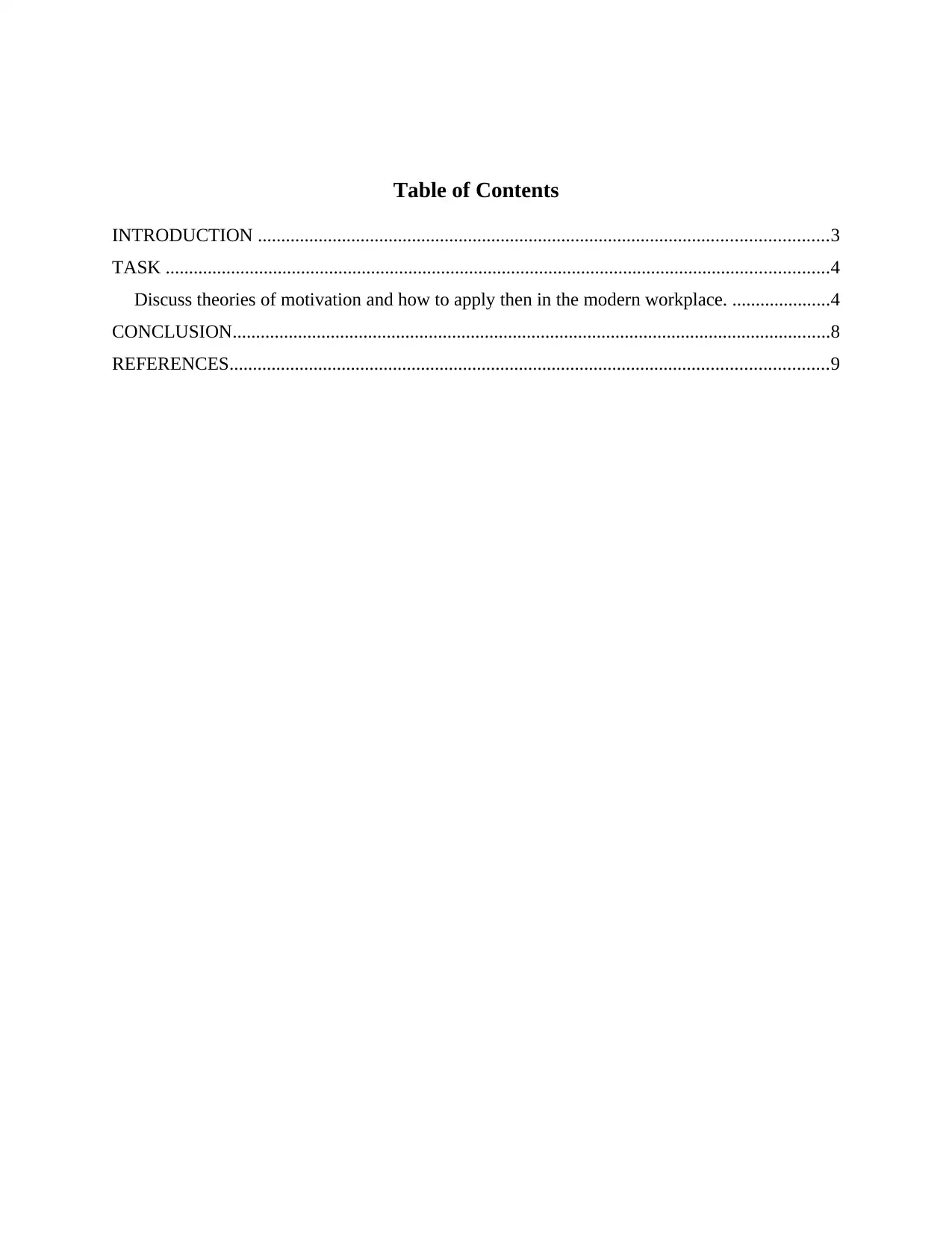
Table of Contents
INTRODUCTION ..........................................................................................................................3
TASK ..............................................................................................................................................4
Discuss theories of motivation and how to apply then in the modern workplace. .....................4
CONCLUSION................................................................................................................................8
REFERENCES................................................................................................................................9
INTRODUCTION ..........................................................................................................................3
TASK ..............................................................................................................................................4
Discuss theories of motivation and how to apply then in the modern workplace. .....................4
CONCLUSION................................................................................................................................8
REFERENCES................................................................................................................................9
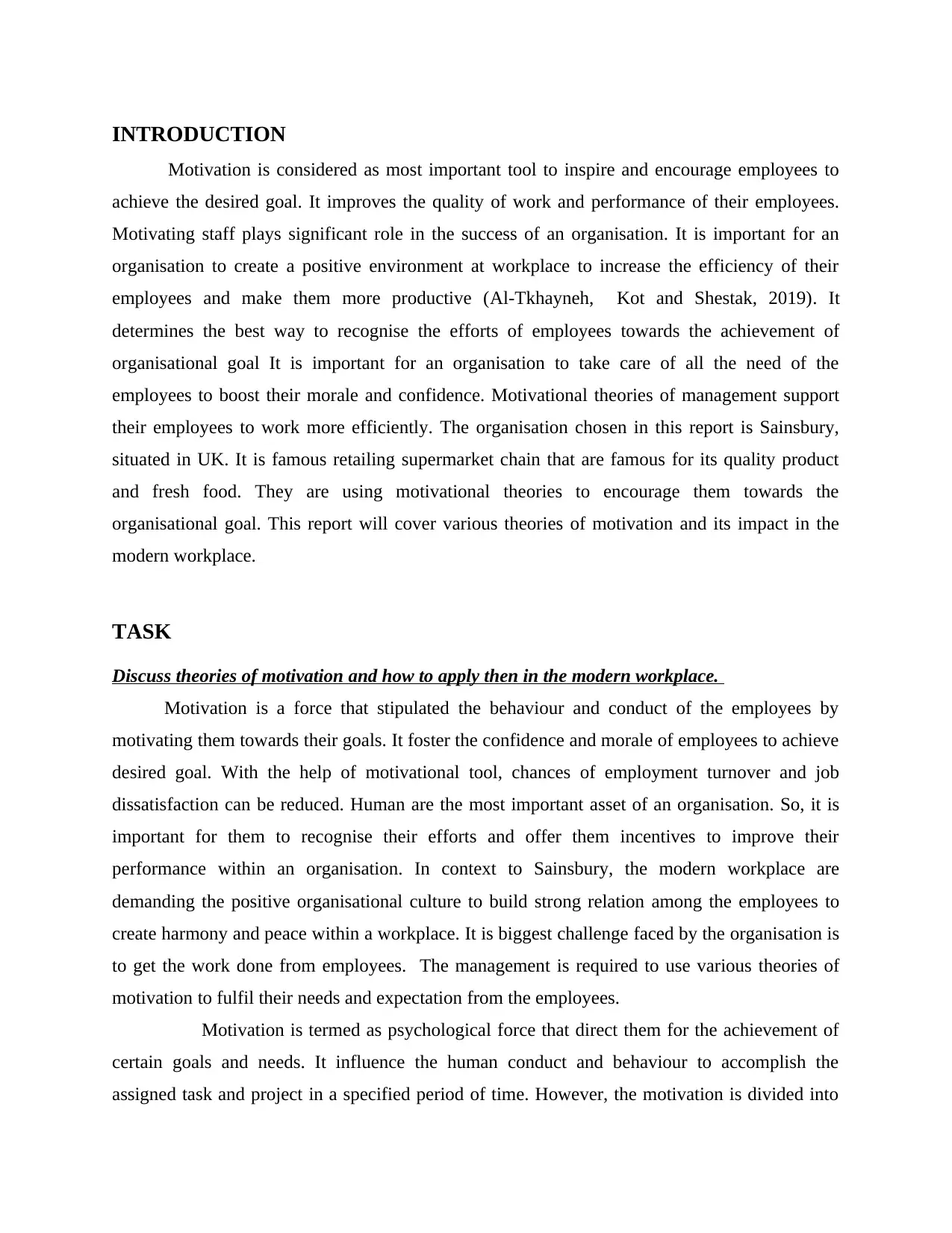
INTRODUCTION
Motivation is considered as most important tool to inspire and encourage employees to
achieve the desired goal. It improves the quality of work and performance of their employees.
Motivating staff plays significant role in the success of an organisation. It is important for an
organisation to create a positive environment at workplace to increase the efficiency of their
employees and make them more productive (Al-Tkhayneh, Kot and Shestak, 2019). It
determines the best way to recognise the efforts of employees towards the achievement of
organisational goal It is important for an organisation to take care of all the need of the
employees to boost their morale and confidence. Motivational theories of management support
their employees to work more efficiently. The organisation chosen in this report is Sainsbury,
situated in UK. It is famous retailing supermarket chain that are famous for its quality product
and fresh food. They are using motivational theories to encourage them towards the
organisational goal. This report will cover various theories of motivation and its impact in the
modern workplace.
TASK
Discuss theories of motivation and how to apply then in the modern workplace.
Motivation is a force that stipulated the behaviour and conduct of the employees by
motivating them towards their goals. It foster the confidence and morale of employees to achieve
desired goal. With the help of motivational tool, chances of employment turnover and job
dissatisfaction can be reduced. Human are the most important asset of an organisation. So, it is
important for them to recognise their efforts and offer them incentives to improve their
performance within an organisation. In context to Sainsbury, the modern workplace are
demanding the positive organisational culture to build strong relation among the employees to
create harmony and peace within a workplace. It is biggest challenge faced by the organisation is
to get the work done from employees. The management is required to use various theories of
motivation to fulfil their needs and expectation from the employees.
Motivation is termed as psychological force that direct them for the achievement of
certain goals and needs. It influence the human conduct and behaviour to accomplish the
assigned task and project in a specified period of time. However, the motivation is divided into
Motivation is considered as most important tool to inspire and encourage employees to
achieve the desired goal. It improves the quality of work and performance of their employees.
Motivating staff plays significant role in the success of an organisation. It is important for an
organisation to create a positive environment at workplace to increase the efficiency of their
employees and make them more productive (Al-Tkhayneh, Kot and Shestak, 2019). It
determines the best way to recognise the efforts of employees towards the achievement of
organisational goal It is important for an organisation to take care of all the need of the
employees to boost their morale and confidence. Motivational theories of management support
their employees to work more efficiently. The organisation chosen in this report is Sainsbury,
situated in UK. It is famous retailing supermarket chain that are famous for its quality product
and fresh food. They are using motivational theories to encourage them towards the
organisational goal. This report will cover various theories of motivation and its impact in the
modern workplace.
TASK
Discuss theories of motivation and how to apply then in the modern workplace.
Motivation is a force that stipulated the behaviour and conduct of the employees by
motivating them towards their goals. It foster the confidence and morale of employees to achieve
desired goal. With the help of motivational tool, chances of employment turnover and job
dissatisfaction can be reduced. Human are the most important asset of an organisation. So, it is
important for them to recognise their efforts and offer them incentives to improve their
performance within an organisation. In context to Sainsbury, the modern workplace are
demanding the positive organisational culture to build strong relation among the employees to
create harmony and peace within a workplace. It is biggest challenge faced by the organisation is
to get the work done from employees. The management is required to use various theories of
motivation to fulfil their needs and expectation from the employees.
Motivation is termed as psychological force that direct them for the achievement of
certain goals and needs. It influence the human conduct and behaviour to accomplish the
assigned task and project in a specified period of time. However, the motivation is divided into
⊘ This is a preview!⊘
Do you want full access?
Subscribe today to unlock all pages.

Trusted by 1+ million students worldwide
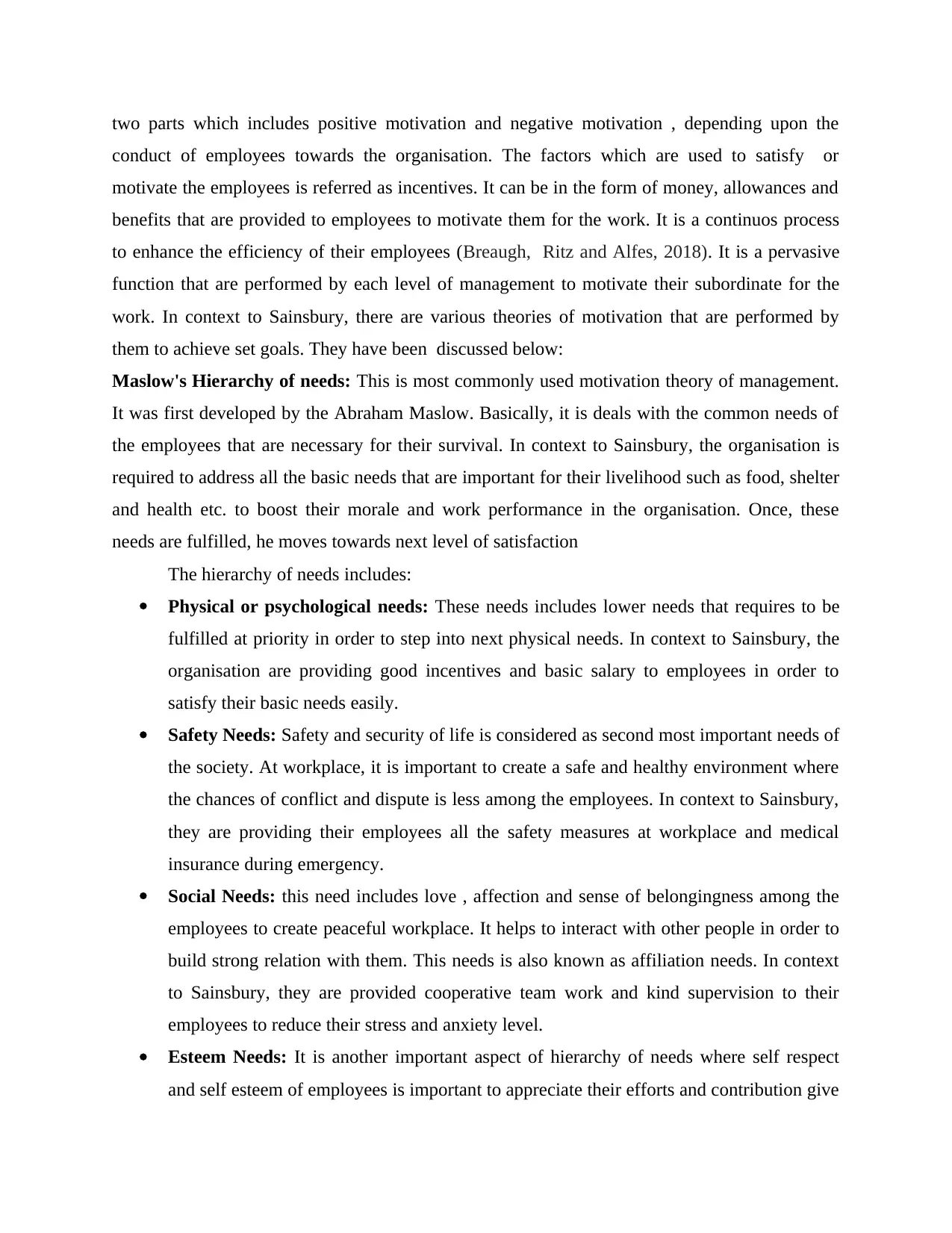
two parts which includes positive motivation and negative motivation , depending upon the
conduct of employees towards the organisation. The factors which are used to satisfy or
motivate the employees is referred as incentives. It can be in the form of money, allowances and
benefits that are provided to employees to motivate them for the work. It is a continuos process
to enhance the efficiency of their employees (Breaugh, Ritz and Alfes, 2018). It is a pervasive
function that are performed by each level of management to motivate their subordinate for the
work. In context to Sainsbury, there are various theories of motivation that are performed by
them to achieve set goals. They have been discussed below:
Maslow's Hierarchy of needs: This is most commonly used motivation theory of management.
It was first developed by the Abraham Maslow. Basically, it is deals with the common needs of
the employees that are necessary for their survival. In context to Sainsbury, the organisation is
required to address all the basic needs that are important for their livelihood such as food, shelter
and health etc. to boost their morale and work performance in the organisation. Once, these
needs are fulfilled, he moves towards next level of satisfaction
The hierarchy of needs includes:
Physical or psychological needs: These needs includes lower needs that requires to be
fulfilled at priority in order to step into next physical needs. In context to Sainsbury, the
organisation are providing good incentives and basic salary to employees in order to
satisfy their basic needs easily.
Safety Needs: Safety and security of life is considered as second most important needs of
the society. At workplace, it is important to create a safe and healthy environment where
the chances of conflict and dispute is less among the employees. In context to Sainsbury,
they are providing their employees all the safety measures at workplace and medical
insurance during emergency.
Social Needs: this need includes love , affection and sense of belongingness among the
employees to create peaceful workplace. It helps to interact with other people in order to
build strong relation with them. This needs is also known as affiliation needs. In context
to Sainsbury, they are provided cooperative team work and kind supervision to their
employees to reduce their stress and anxiety level.
Esteem Needs: It is another important aspect of hierarchy of needs where self respect
and self esteem of employees is important to appreciate their efforts and contribution give
conduct of employees towards the organisation. The factors which are used to satisfy or
motivate the employees is referred as incentives. It can be in the form of money, allowances and
benefits that are provided to employees to motivate them for the work. It is a continuos process
to enhance the efficiency of their employees (Breaugh, Ritz and Alfes, 2018). It is a pervasive
function that are performed by each level of management to motivate their subordinate for the
work. In context to Sainsbury, there are various theories of motivation that are performed by
them to achieve set goals. They have been discussed below:
Maslow's Hierarchy of needs: This is most commonly used motivation theory of management.
It was first developed by the Abraham Maslow. Basically, it is deals with the common needs of
the employees that are necessary for their survival. In context to Sainsbury, the organisation is
required to address all the basic needs that are important for their livelihood such as food, shelter
and health etc. to boost their morale and work performance in the organisation. Once, these
needs are fulfilled, he moves towards next level of satisfaction
The hierarchy of needs includes:
Physical or psychological needs: These needs includes lower needs that requires to be
fulfilled at priority in order to step into next physical needs. In context to Sainsbury, the
organisation are providing good incentives and basic salary to employees in order to
satisfy their basic needs easily.
Safety Needs: Safety and security of life is considered as second most important needs of
the society. At workplace, it is important to create a safe and healthy environment where
the chances of conflict and dispute is less among the employees. In context to Sainsbury,
they are providing their employees all the safety measures at workplace and medical
insurance during emergency.
Social Needs: this need includes love , affection and sense of belongingness among the
employees to create peaceful workplace. It helps to interact with other people in order to
build strong relation with them. This needs is also known as affiliation needs. In context
to Sainsbury, they are provided cooperative team work and kind supervision to their
employees to reduce their stress and anxiety level.
Esteem Needs: It is another important aspect of hierarchy of needs where self respect
and self esteem of employees is important to appreciate their efforts and contribution give
Paraphrase This Document
Need a fresh take? Get an instant paraphrase of this document with our AI Paraphraser
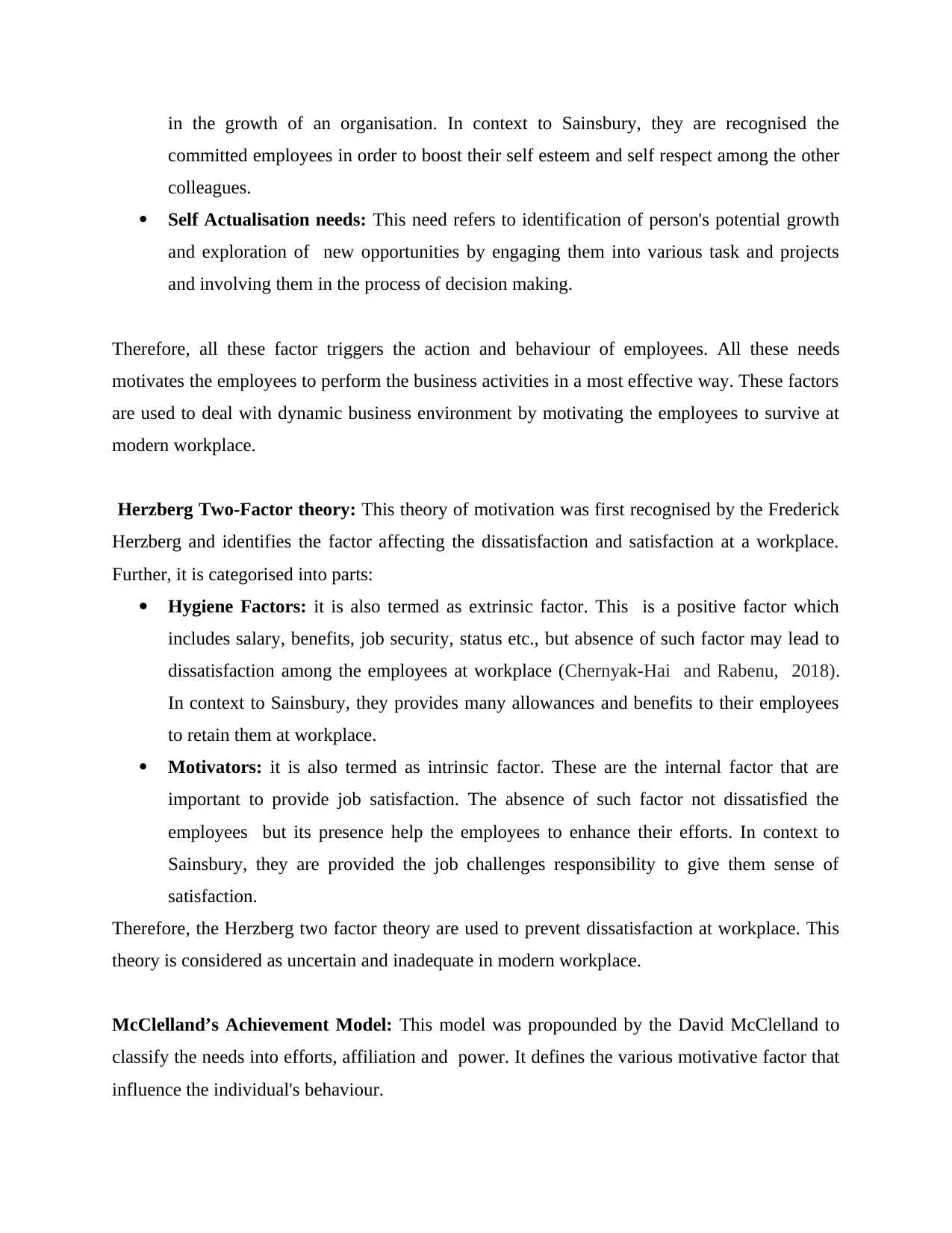
in the growth of an organisation. In context to Sainsbury, they are recognised the
committed employees in order to boost their self esteem and self respect among the other
colleagues.
Self Actualisation needs: This need refers to identification of person's potential growth
and exploration of new opportunities by engaging them into various task and projects
and involving them in the process of decision making.
Therefore, all these factor triggers the action and behaviour of employees. All these needs
motivates the employees to perform the business activities in a most effective way. These factors
are used to deal with dynamic business environment by motivating the employees to survive at
modern workplace.
Herzberg Two-Factor theory: This theory of motivation was first recognised by the Frederick
Herzberg and identifies the factor affecting the dissatisfaction and satisfaction at a workplace.
Further, it is categorised into parts:
Hygiene Factors: it is also termed as extrinsic factor. This is a positive factor which
includes salary, benefits, job security, status etc., but absence of such factor may lead to
dissatisfaction among the employees at workplace (Chernyak-Hai and Rabenu, 2018).
In context to Sainsbury, they provides many allowances and benefits to their employees
to retain them at workplace.
Motivators: it is also termed as intrinsic factor. These are the internal factor that are
important to provide job satisfaction. The absence of such factor not dissatisfied the
employees but its presence help the employees to enhance their efforts. In context to
Sainsbury, they are provided the job challenges responsibility to give them sense of
satisfaction.
Therefore, the Herzberg two factor theory are used to prevent dissatisfaction at workplace. This
theory is considered as uncertain and inadequate in modern workplace.
McClelland’s Achievement Model: This model was propounded by the David McClelland to
classify the needs into efforts, affiliation and power. It defines the various motivative factor that
influence the individual's behaviour.
committed employees in order to boost their self esteem and self respect among the other
colleagues.
Self Actualisation needs: This need refers to identification of person's potential growth
and exploration of new opportunities by engaging them into various task and projects
and involving them in the process of decision making.
Therefore, all these factor triggers the action and behaviour of employees. All these needs
motivates the employees to perform the business activities in a most effective way. These factors
are used to deal with dynamic business environment by motivating the employees to survive at
modern workplace.
Herzberg Two-Factor theory: This theory of motivation was first recognised by the Frederick
Herzberg and identifies the factor affecting the dissatisfaction and satisfaction at a workplace.
Further, it is categorised into parts:
Hygiene Factors: it is also termed as extrinsic factor. This is a positive factor which
includes salary, benefits, job security, status etc., but absence of such factor may lead to
dissatisfaction among the employees at workplace (Chernyak-Hai and Rabenu, 2018).
In context to Sainsbury, they provides many allowances and benefits to their employees
to retain them at workplace.
Motivators: it is also termed as intrinsic factor. These are the internal factor that are
important to provide job satisfaction. The absence of such factor not dissatisfied the
employees but its presence help the employees to enhance their efforts. In context to
Sainsbury, they are provided the job challenges responsibility to give them sense of
satisfaction.
Therefore, the Herzberg two factor theory are used to prevent dissatisfaction at workplace. This
theory is considered as uncertain and inadequate in modern workplace.
McClelland’s Achievement Model: This model was propounded by the David McClelland to
classify the needs into efforts, affiliation and power. It defines the various motivative factor that
influence the individual's behaviour.
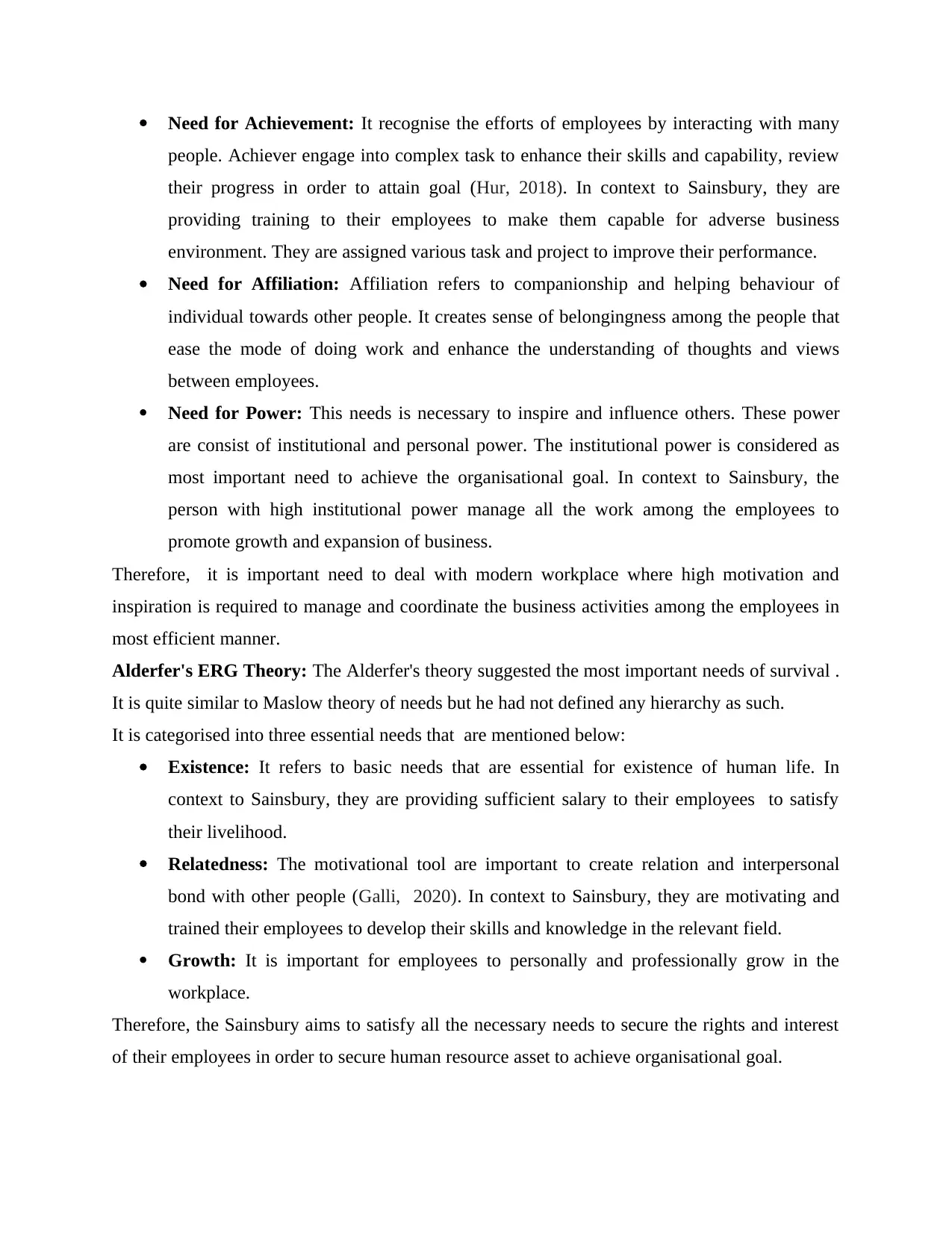
Need for Achievement: It recognise the efforts of employees by interacting with many
people. Achiever engage into complex task to enhance their skills and capability, review
their progress in order to attain goal (Hur, 2018). In context to Sainsbury, they are
providing training to their employees to make them capable for adverse business
environment. They are assigned various task and project to improve their performance.
Need for Affiliation: Affiliation refers to companionship and helping behaviour of
individual towards other people. It creates sense of belongingness among the people that
ease the mode of doing work and enhance the understanding of thoughts and views
between employees.
Need for Power: This needs is necessary to inspire and influence others. These power
are consist of institutional and personal power. The institutional power is considered as
most important need to achieve the organisational goal. In context to Sainsbury, the
person with high institutional power manage all the work among the employees to
promote growth and expansion of business.
Therefore, it is important need to deal with modern workplace where high motivation and
inspiration is required to manage and coordinate the business activities among the employees in
most efficient manner.
Alderfer's ERG Theory: The Alderfer's theory suggested the most important needs of survival .
It is quite similar to Maslow theory of needs but he had not defined any hierarchy as such.
It is categorised into three essential needs that are mentioned below:
Existence: It refers to basic needs that are essential for existence of human life. In
context to Sainsbury, they are providing sufficient salary to their employees to satisfy
their livelihood.
Relatedness: The motivational tool are important to create relation and interpersonal
bond with other people (Galli, 2020). In context to Sainsbury, they are motivating and
trained their employees to develop their skills and knowledge in the relevant field.
Growth: It is important for employees to personally and professionally grow in the
workplace.
Therefore, the Sainsbury aims to satisfy all the necessary needs to secure the rights and interest
of their employees in order to secure human resource asset to achieve organisational goal.
people. Achiever engage into complex task to enhance their skills and capability, review
their progress in order to attain goal (Hur, 2018). In context to Sainsbury, they are
providing training to their employees to make them capable for adverse business
environment. They are assigned various task and project to improve their performance.
Need for Affiliation: Affiliation refers to companionship and helping behaviour of
individual towards other people. It creates sense of belongingness among the people that
ease the mode of doing work and enhance the understanding of thoughts and views
between employees.
Need for Power: This needs is necessary to inspire and influence others. These power
are consist of institutional and personal power. The institutional power is considered as
most important need to achieve the organisational goal. In context to Sainsbury, the
person with high institutional power manage all the work among the employees to
promote growth and expansion of business.
Therefore, it is important need to deal with modern workplace where high motivation and
inspiration is required to manage and coordinate the business activities among the employees in
most efficient manner.
Alderfer's ERG Theory: The Alderfer's theory suggested the most important needs of survival .
It is quite similar to Maslow theory of needs but he had not defined any hierarchy as such.
It is categorised into three essential needs that are mentioned below:
Existence: It refers to basic needs that are essential for existence of human life. In
context to Sainsbury, they are providing sufficient salary to their employees to satisfy
their livelihood.
Relatedness: The motivational tool are important to create relation and interpersonal
bond with other people (Galli, 2020). In context to Sainsbury, they are motivating and
trained their employees to develop their skills and knowledge in the relevant field.
Growth: It is important for employees to personally and professionally grow in the
workplace.
Therefore, the Sainsbury aims to satisfy all the necessary needs to secure the rights and interest
of their employees in order to secure human resource asset to achieve organisational goal.
⊘ This is a preview!⊘
Do you want full access?
Subscribe today to unlock all pages.

Trusted by 1+ million students worldwide
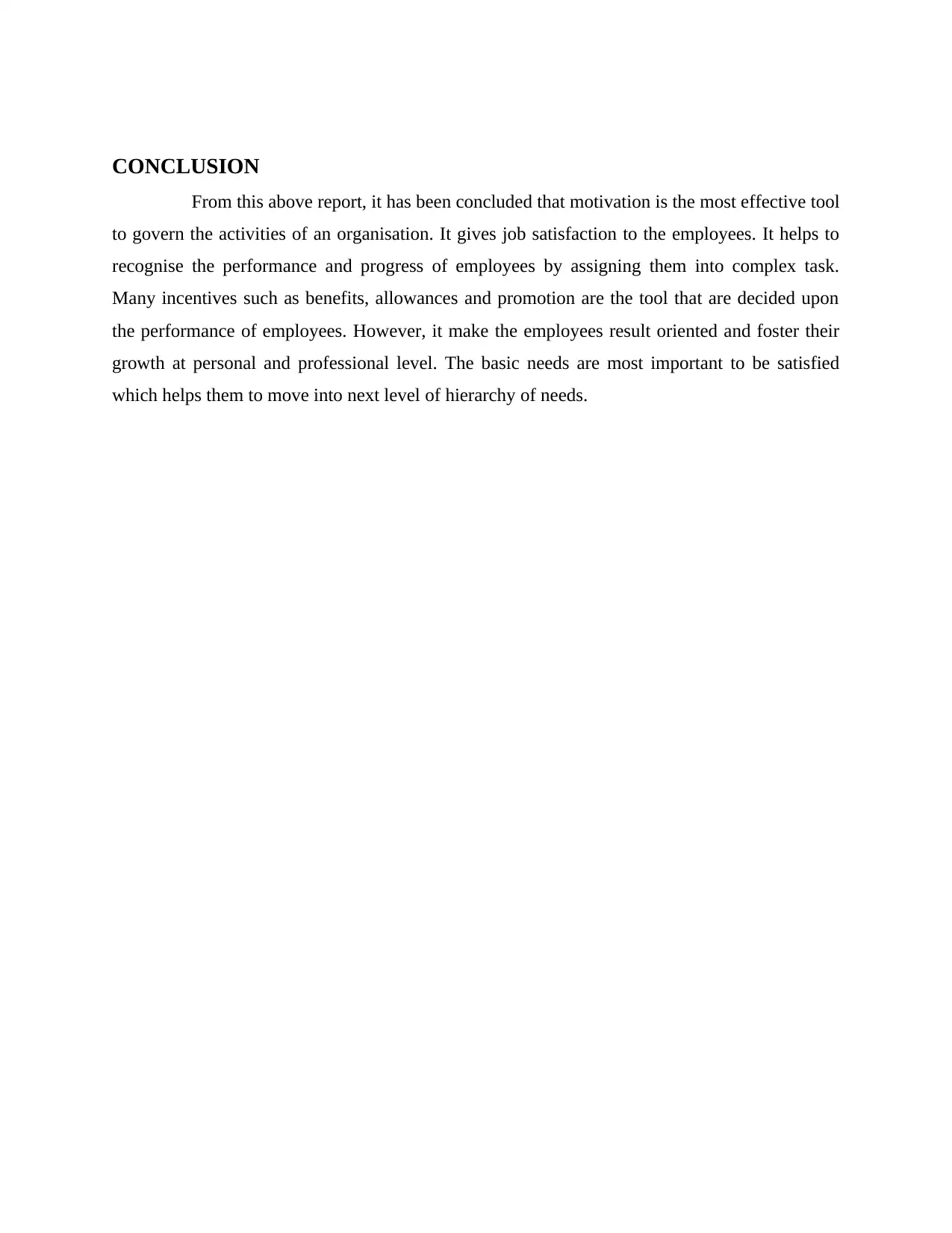
CONCLUSION
From this above report, it has been concluded that motivation is the most effective tool
to govern the activities of an organisation. It gives job satisfaction to the employees. It helps to
recognise the performance and progress of employees by assigning them into complex task.
Many incentives such as benefits, allowances and promotion are the tool that are decided upon
the performance of employees. However, it make the employees result oriented and foster their
growth at personal and professional level. The basic needs are most important to be satisfied
which helps them to move into next level of hierarchy of needs.
From this above report, it has been concluded that motivation is the most effective tool
to govern the activities of an organisation. It gives job satisfaction to the employees. It helps to
recognise the performance and progress of employees by assigning them into complex task.
Many incentives such as benefits, allowances and promotion are the tool that are decided upon
the performance of employees. However, it make the employees result oriented and foster their
growth at personal and professional level. The basic needs are most important to be satisfied
which helps them to move into next level of hierarchy of needs.
Paraphrase This Document
Need a fresh take? Get an instant paraphrase of this document with our AI Paraphraser
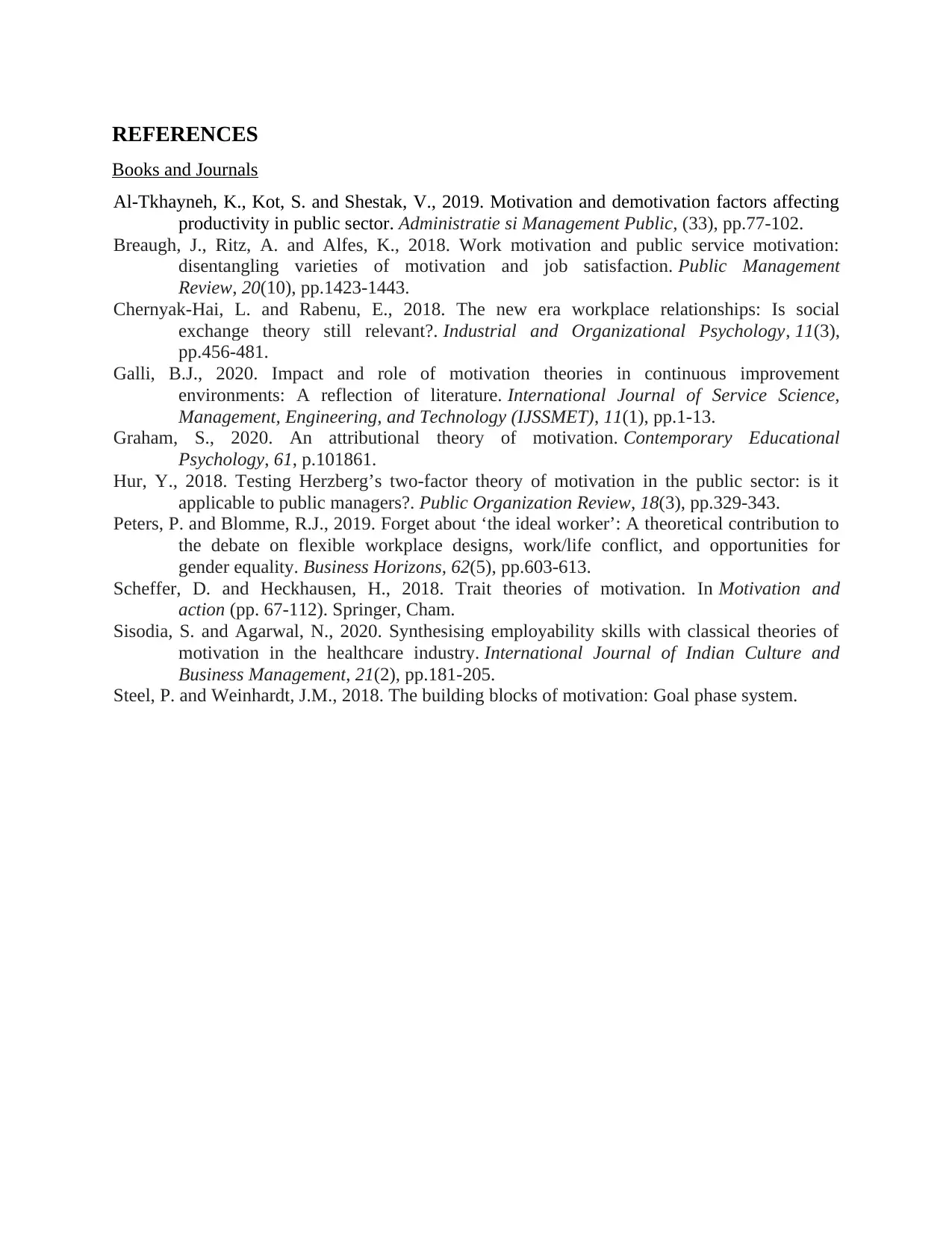
REFERENCES
Books and Journals
Al-Tkhayneh, K., Kot, S. and Shestak, V., 2019. Motivation and demotivation factors affecting
productivity in public sector. Administratie si Management Public, (33), pp.77-102.
Breaugh, J., Ritz, A. and Alfes, K., 2018. Work motivation and public service motivation:
disentangling varieties of motivation and job satisfaction. Public Management
Review, 20(10), pp.1423-1443.
Chernyak-Hai, L. and Rabenu, E., 2018. The new era workplace relationships: Is social
exchange theory still relevant?. Industrial and Organizational Psychology, 11(3),
pp.456-481.
Galli, B.J., 2020. Impact and role of motivation theories in continuous improvement
environments: A reflection of literature. International Journal of Service Science,
Management, Engineering, and Technology (IJSSMET), 11(1), pp.1-13.
Graham, S., 2020. An attributional theory of motivation. Contemporary Educational
Psychology, 61, p.101861.
Hur, Y., 2018. Testing Herzberg’s two-factor theory of motivation in the public sector: is it
applicable to public managers?. Public Organization Review, 18(3), pp.329-343.
Peters, P. and Blomme, R.J., 2019. Forget about ‘the ideal worker’: A theoretical contribution to
the debate on flexible workplace designs, work/life conflict, and opportunities for
gender equality. Business Horizons, 62(5), pp.603-613.
Scheffer, D. and Heckhausen, H., 2018. Trait theories of motivation. In Motivation and
action (pp. 67-112). Springer, Cham.
Sisodia, S. and Agarwal, N., 2020. Synthesising employability skills with classical theories of
motivation in the healthcare industry. International Journal of Indian Culture and
Business Management, 21(2), pp.181-205.
Steel, P. and Weinhardt, J.M., 2018. The building blocks of motivation: Goal phase system.
Books and Journals
Al-Tkhayneh, K., Kot, S. and Shestak, V., 2019. Motivation and demotivation factors affecting
productivity in public sector. Administratie si Management Public, (33), pp.77-102.
Breaugh, J., Ritz, A. and Alfes, K., 2018. Work motivation and public service motivation:
disentangling varieties of motivation and job satisfaction. Public Management
Review, 20(10), pp.1423-1443.
Chernyak-Hai, L. and Rabenu, E., 2018. The new era workplace relationships: Is social
exchange theory still relevant?. Industrial and Organizational Psychology, 11(3),
pp.456-481.
Galli, B.J., 2020. Impact and role of motivation theories in continuous improvement
environments: A reflection of literature. International Journal of Service Science,
Management, Engineering, and Technology (IJSSMET), 11(1), pp.1-13.
Graham, S., 2020. An attributional theory of motivation. Contemporary Educational
Psychology, 61, p.101861.
Hur, Y., 2018. Testing Herzberg’s two-factor theory of motivation in the public sector: is it
applicable to public managers?. Public Organization Review, 18(3), pp.329-343.
Peters, P. and Blomme, R.J., 2019. Forget about ‘the ideal worker’: A theoretical contribution to
the debate on flexible workplace designs, work/life conflict, and opportunities for
gender equality. Business Horizons, 62(5), pp.603-613.
Scheffer, D. and Heckhausen, H., 2018. Trait theories of motivation. In Motivation and
action (pp. 67-112). Springer, Cham.
Sisodia, S. and Agarwal, N., 2020. Synthesising employability skills with classical theories of
motivation in the healthcare industry. International Journal of Indian Culture and
Business Management, 21(2), pp.181-205.
Steel, P. and Weinhardt, J.M., 2018. The building blocks of motivation: Goal phase system.
1 out of 8
Related Documents
Your All-in-One AI-Powered Toolkit for Academic Success.
+13062052269
info@desklib.com
Available 24*7 on WhatsApp / Email
![[object Object]](/_next/static/media/star-bottom.7253800d.svg)
Unlock your academic potential
Copyright © 2020–2025 A2Z Services. All Rights Reserved. Developed and managed by ZUCOL.



